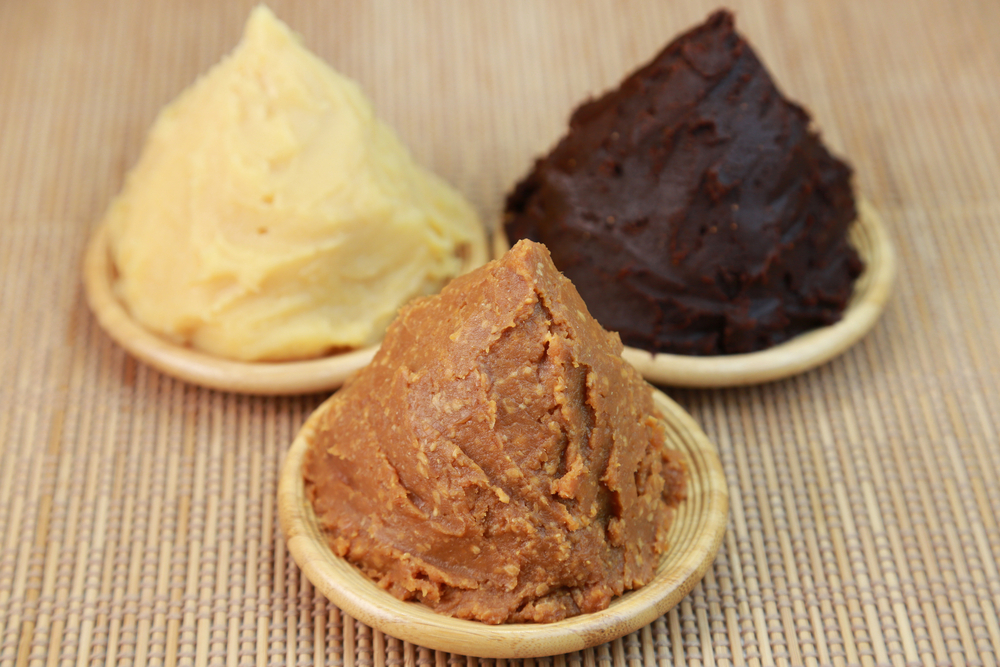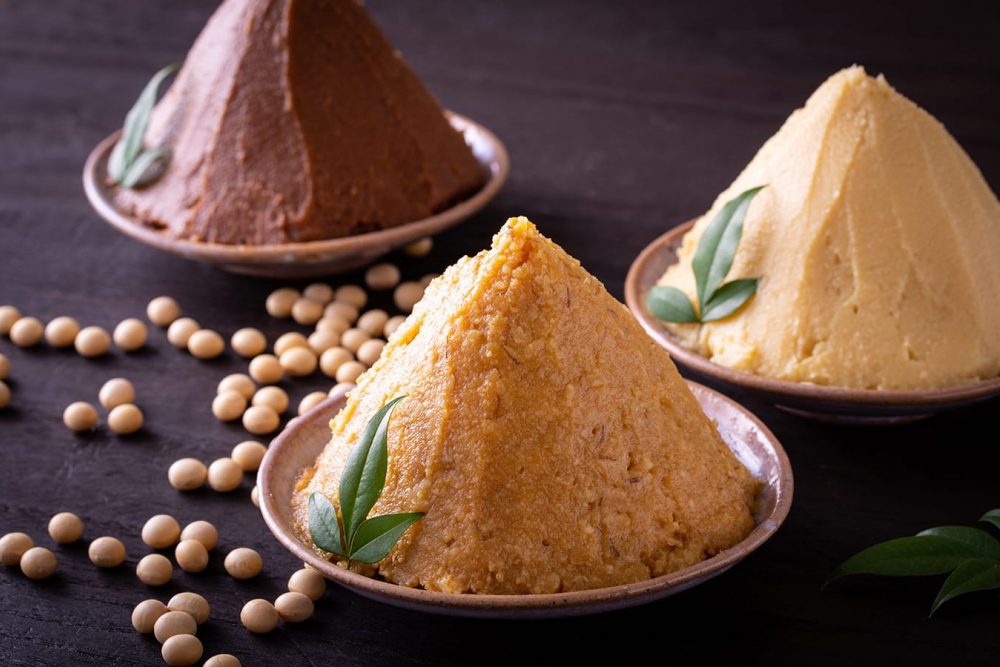Salty, savory, funky and full of umami, Japanese miso is one of our favorite pantry staples at Milk Street. Made by fermenting and aging soybean paste until it develops rich umami flavor, miso lends depth to recipes from simple soups and dressings to meat marinades. There are many kinds, coming in a range of warm, earthy colors, ranging from sweeter, buttery white varieties to dark, rich, red ones. But what is miso paste, exactly, and how do you use it? We’re here to answer all your miso questions.
WHAT IS MISO AND WHAT IS IT MADE FROM?
Fermented soybean paste was brought to Japan by Buddhist monks around 700 A.D., evolving into miso over hundreds of years. Eventually, miso was made by combining cooked soybeans and grains—rice, barley or both, depending on the variety—plus salt water and a starter culture called koji, usually made from fermented rice.
The mixture traditionally was fermented during summer in cedar wood vats, then left to age anywhere from six months to five years. A pile of stones on the lid compressed the solids, and the paste thickened with time to a texture similar to grainy peanut butter, though some are smoother or chunkier than others. The liquid byproduct, called tamari, is an ingredient itself, similar to soy sauce (shoyu) but thicker and less salty.
WHAT ARE THE DIFFERENT TYPES OF MISO?
This is where things get complicated. The Japanese categorize miso three ways, by color, ingredient and taste. The ingredient category refers to the what the koji is made from, either soybeans (mame), barley (mugi) or rice (kome). When it comes to taste, they are divided into sweet (ama), salty (karakuchi) and mild (amakuchi), though all misos are assumed to be salty. But in the U.S., you’ll most likely search for miso based on color, that is, white (shiro), red (aka) or yellow, which in Japan goes by the term blended (awase).
White miso is the sweetest of the three, made from about 40 percent soybeans and 60 percent rice or barley. The soybeans are boiled before being mixed with the other ingredients, which preserves the lighter color and milder flavor. Red miso has a longer fermentation time and a higher ratio of grains to soybeans, which are steamed instead of boiled. That distinction allows amino acids to react with the sugars, darkening the color and resulting in a richer flavor. Yellow miso is a blend of the two, which makes some cooks say it’s the most versatile choice.

A MISO PRO TIP
It may sound a little out there, but white miso pairs well with sweet. Try adding a little to your next batch of caramel sauce for a savory counterpoint to the sticky sweetness. Wait until the caramel has cooled a bit before whisking in 1 teaspoon at a time, tasting in between additions. You’ll never know its there, but you’ll miss it when it isn’t.
WHAT DOES MISO TASTE LIKE?
Miso can be buttery and sweet or earthy, savory and robust. Sometimes it is a main ingredient; other times, its savoriness adds a background richness to sauces, marinades, even desserts. Either way, it generally just makes food better.
Though brands differ, it’s a good rule of thumb to think that darker miso will be richer, funkier and saltier, while lighter miso will be sweeter and more delicate. Because of the fermentation, it develops complex, sharp and funky flavors that are hard to pin down, but taste better than they sound. And as a fermented food, it’s great for digestive health.
HOW TO USE MISO
Miso works well in many foods, especially soups, dressings, marinades and glazes. There also are plenty of surprising ways where it shines in recipes that have nothing to do with traditional Japanese food. A teaspoon mixed into a pan sauce after sautéing meat, for instance, punches up the savory flavors. But be sure to whisk it with another liquid first to distribute the flavor instead of sticking to other ingredients in clumps.
We like miso as an easy, complex soup base, whether for a classic miso soup or to add body and richness to your favorite chicken soup. It lends amazing depth to our bulked-up Pork and Vegetable Miso Soup (Ton-Jiru). For a dirt-simple, surprisingly flavorful alternative to boxed broth, you can make a quick Miso Broth with garlic, shallot and ginger. Use it anywhere you might use vegetable or chicken broth, in stews, risotto or grains.
Or try it in a simple compound butter. Mix equal parts softened butter with white miso for a do-it-all flavoring to slather on everything from chicken to blanched vegetables and pasta or rice. It’s particularly good with asparagus, like with our Soba Noodles with Miso Butter and Asparagus.
It even could be salmon’s greatest ally. In our quick Miso-Glazed Broiled Salmon, miso paste is blended with honey, mirin, soy sauce, sesame and cayenne pepper, making a perfect glaze. And red miso lends deep, rich, savory flavor to our Pan-Seared Miso Marinated Steak.
HOW TO STORE MISO
Since it is a very salty product, miso lasts a long time when sealed tightly and stored in the refrigerator. Generally, the date on the package is a best-by date for peak freshness, but it can last for years. The color will darken and it will dry out with time, but generally it will be safe to eat. However, there are notable exceptions. If it smells off at all, or if any mold appears on the surface, throw it out. That’s more likely to happen if you don’t use a fresh, clean spoon when scooping it out of a tub.
Join the conversation on Facebook, Twitter, Instagram and Pinterest!
RELATED POSTS
Get Ready to Cook
6
Servings
30 minutes
Get Ready to Cook
4
Servings
40 minutes
Get Ready to Cook
4
Servings
30 minutes
Get Ready to Cook
4
Servings
35 minutes
Get Ready to Cook
4
Servings
25 minutes
Get Ready to Cook
1½
Dozen cookies
50 minutes
plus chilling and cooling
Get Ready to Cook
4
Servings




